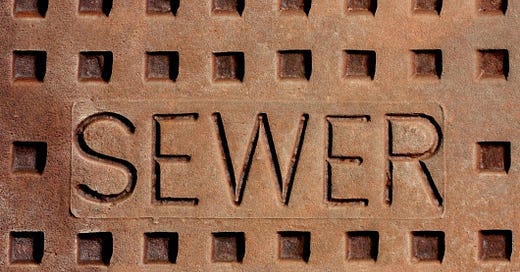The Public Health™ authorities, now that public enthusiasm for the PCR nasal rape ritual to go to work or school has waned, have taken up a new method for allegedly detecting COVID levels in the population: sifting through shit.
This is how The Science™ of “wastewater surveillance” works in a nutshell:
· Scoop a tiny sample of raw sewage into a water bottle (literally; more on that coming up)
· Run PCR test/scam
· Allegedly find SARS-Cov-2 genetic material
· Leverage findings to generate fear porn in corporate state media for a fresh news cycle
· Repeat as necessary
As alluded to previously, the process literally consists of samples collected at random — drops in the proverbial ocean of sewage — in plastic bottles to run down to the local lab for analysis.
Via World Health Organization (emphasis added):
“Twice a week, a team of scientists from South Africa’s National Institute for Communicable Diseases (NICD) traverses the country’s metropolitan areas, visiting up to 50 wastewater treatment sites to fill bottles with effluent. The bottles are sealed and disinfected, then transported to a network of laboratories across the country where their contents will be tested for the presence of SARS-CoV-2, the virus that causes COVID-19.
This kind of wastewater surveillance has been used for decades to detect and monitor the spread of viruses and pathogens including cholera, poliovirus, noroviruses and influenza. Now the emergence of COVID-19 has reiterated its role as a cost-effective tool for disease monitoring and the early detection of community infection.”
The highly scientific bottles of sewage (again, needles in the haystack of the overall sewage content in any given locality) are then processed through the trusty PCR analysis, which does not look for whole bits of virus —not to mention active human infection — but rather fragments of viral RNA.
Related: WHO advertises debunked bird flu PCR fraud
Via Water Canada (emphasis added):
““In my lab, we process from raw wastewater and simply centrifuge the samples to collect the pellet (solids) and then extract for RNA [ribonucleic acid]. Although there are minor differences in the exact protocol between labs, the overall process is very similar,” explains Gilbride. “Different variants just require different primers for the RT-qPCR [reverse transcription quantitative real-time PCR] step. I think that every RT-qPCR reaction gives us accurate results, and all those using this analytical method get very similar results. However, the variation we see in detection — between samples, between labs, and between sites — is mostly due to the variation in the sample we are testing.””
How does The Science™ account for variability in the sewage samples collected, which represent a tiny portion of the available liquid-solidish gold flowing through the water supply?
Let the lady explain via chicken soup metaphor:
“What are they key challenges involved in providing accurate surveillance results?
The best way to explain this, according to [professor and acting associated dean for the faculty of science at Toronto Metropolitan University (TMU) in Toronto, Ontario Dr. Kimberley] Gilbride, is to imagine that wastewater is chicken vegetable soup. When you take a spoonful, you cannot guarantee that you pick up exactly the same number of carrots pieces each time. Even if you stirred the soup before portioning it into bowls, each bowl would not have exactly the same numbers of carrots or chicken in their bowl; hence, variation. The same thing happens with wastewater samples; some samples are more homogenous than others. (For example, poop comes in different consistencies and therefore single samples may vary.)
Gilbride adds that they normalize their COVID RNA copies with pepper mild mottle virus (PMMoV) since the latter is common in diets (but again may vary between different locations) and its presence in waste represents the amount of poop when analyzing for COVID.
“So, in other words, if we count chicken pieces in the soup, we can predict how much soup we are analyzing assuming the soup is homogeneous. Then, when we look for COVID, we determine how many carrots we have relative to chicken to see if the signal is going up, going down or steady. The challenge is always with the sample we get in the first place.”
How homogeneous is it? “It’s very hard to standardize unless we could get everyone to give us standardized poop samples — impossible! Having said all of this, the normalization with PMMoV has worked extremely well.””
So, their foolproof analytical method is to test — again, using flawed PCR — for another common virus, pepper mild mottle virus, to determine that what they’re looking at is actually human fecal matter, and by that standard they can safely divine that they’re got real shit on their hands and, further, that the SARS-CoV-2 virus they find is representative of the population-level infection rates, even though they never looked for active infection in the first place and simply went seeking viral fragments, which mean nothing much at all in terms of illness or death.
But it’s great for the economy, I guess. Feces collectors need jobs, too. How many leftists would go scavenging sewers for treasure for free anyway? Why not put them to work in noble service to The Science™?
Ben Bartee is an independent Bangkok-based American journalist with opposable thumbs.
Follow his stuff via Substack. Also, keep tabs via Twitter.
For hip Armageddon Prose t-shirts, hats, etc., peruse the merch store.
Support always welcome via the digital tip jar.
Bitcoin public address: bc1qvq4hgnx3eu09e0m2kk5uanxnm8ljfmpefwhawv




Ben, are you poking fun at The Science? Be glad you don’t live in the UK.
Ben knows enough science to get mad at silly things. Then again, mad is sort of Ben's base point. And I like that.
If anyone came out of the whole Covid thing and wasn't mad, they aren't very smart.